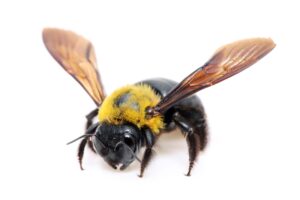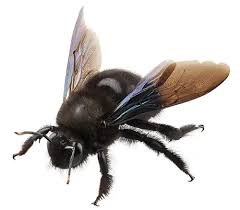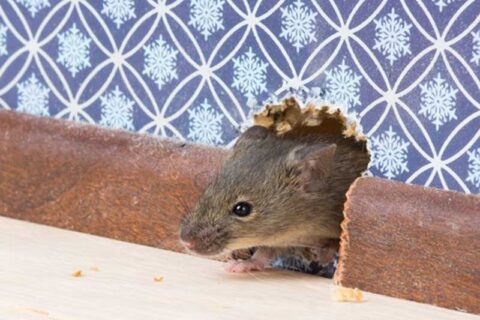Carpenter Bees: Nuisance but Essential Pollinators


Dealing with Carpenter Bees
You’ve probably heard about the struggles that bees face, and how important it is to protect these vital pollinators. If you have carpenter bees, though, you may be wondering if all the pro-bee rhetoric applies to these destructive, wood-boring insects. The answer is yes, which may seem unfortunate to you if you are looking to eradicate them from your property. It is certainly a complicated issue, but here, we’ll look closely at the best ways to deal with these pests without disrupting the natural ecosystem.
Let’s Talk About Pollination
Pollinator importance can truly not be overstated. According to the USDA, pollination is “an essential ecological survival function. Without pollinators, the human race and all of the earth’s terrestrial ecosystems would not survive.” If that sounds like hyperbole, consider that about 80 percent of crop plants grown around the world require pollination by animals, and 15 percent of our agricultural crops are pollinated by native bees like the carpenter bee. What’s more, pollinators are crucial to the survival of flowering plants, which produce breathable oxygen, purify water, and prevent soil erosion. Say what you will about carpenter bees, they are amazing pollinators. They use a technique called buzz pollination, which is also employed by bumble bees and stingless bees, vibrating plants vigorously to release an optimal amount of pollen. Does this mean you shouldn’t try to get rid of carpenter bees on your property?
Understanding Carpenter Bees
There are about twenty thousand species of bees, classified into nine families and divided into three broad groups, depending on the length of the bee’s tongue, or proboscis. Carpenter bees are long-tongued bees and, along with the bumble bee, are the largest native bees in the United States. They are solitary insects, and while they are important pollinators, that doesn’t negate their destructive behavior. The name comes from their nesting habits because they dig and burrow into wood. They don’t eat wood, instead feeding on nectar from flowers, but they chew through the wood to make their nests. Even their reproductive cycle is dependent on tunneling into wood: the female carpenter bee digs a tunnel into the wood, makes a ball of “bee bread” from nectar and pollen, and lays her eggs on it. After that, she seals the tunnel with sawdust chips, leaving just the small chamber where the eggs are located. Once the young bees finish off their bee bread, they dig their way out of the hive. From there, they fly off to find new homes, chewing perfectly round holes into wood to create galleries in which to live. These nests are used for protection, laying eggs, and storing food, and the tunnels can sometimes be up to 10 feet long. Carpenter bees prefer hardwoods like cedar, redwood, and cypress, but they will also attack pine and other species, boring holes quickly in a short period of time. These native pollinators need to have places to nest, but you don’t need to let them nest in your home.
The Trouble with Carpenter Bees
When carpenter bees bore their tunnels into the wood, they start by going straight in, but they soon turn to tunnel along the grain of the wood. These tunnels weaken the wood, leading to significant structural damage. Because carpenter bees don’t live exclusively inside the wood, they go in and out, enjoying the fresh air and sunshine before heading back to bore another hole. Untreated wood, in a fence, a deck, or a shed, for example, can quickly suffer damage from carpenter bees, so it’s important to paint, stain, or treat any wood in your yard. Carpenter bees can attack your home, as well, and the holes they bore cause trouble in several different ways. In addition to the structural damage they do, they can also cause water damage to a house, if they build their tunnels in weather exposed areas. What’s more, because carpenter bees are a favorite food of woodpeckers, these birds will drill into your home if carpenter bees are present, looking for a meal.
Do You Have Carpenter Bees?
Sometimes, people mistake bumble bees for carpenter bees, and vice versa. So, how do you know if the bees you’re seeing are friendly little bumble bees or destructive carpenter bees? Both carpenter bees and bumble bees are dark and can have an orange or yellow color, but there are some significant differences. The carpenter bees have bare, black, shiny abdomens, as opposed to the fuzzy, yellow, and black abdomen of a bumble bee. Additionally, bumble bees are social insects, so you’re likely to see a crowd, while carpenter bees are solitary and self-reliant.
Avoiding Infestation While Protecting the Ecosystem
As is the case with many garden pests, when it comes to carpenter bees, prevention is the best cure. The first step is to treat your wood, as carpenter bees need to see or feel the wood grain to understand that it is wood. Painted surfaces that are kept well sealed are much less likely to be the target of carpenter bees than untreated or stained wood. Beyond that, there are several different ways to keep carpenter bees at bay. Applying citrus spray or almond oil wood treatment is an effective method of bee control, and there are other repellents available as well. It’s also very important to seal up any holes you find because carpenter bees are attracted to existing holes. Of course, you will need to make sure there are no bees in the holes when you caulk them because live bees will tunnel right through the caulk or will create a new hole to get out.
Contact MightyMite Termite Services for Help
If you notice damage to your home’s wooden surfaces, it is a good idea to have it inspected by the pest termite control professionals at MightyMite Termite Services. At MightyMite, we’ve earned a reputation as experts in California termite control, and we can handle other pests, too. Our experience and highly trained, licensed and professional staff make us the leading extermination company in the Bay Area. For more information, email Info@mightymitetermite.com, call us today at 408.335.7053, or contact us through our website.









